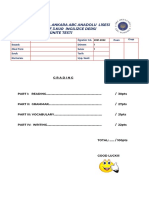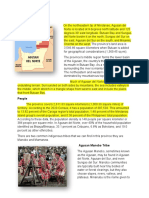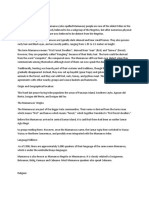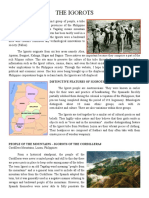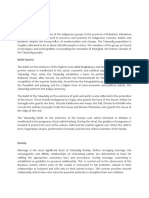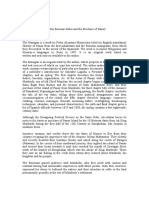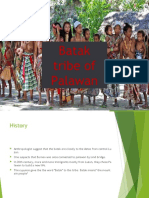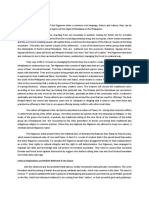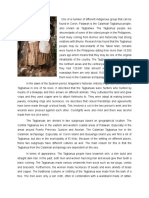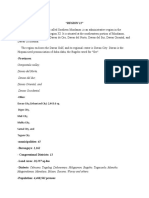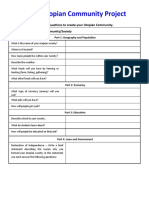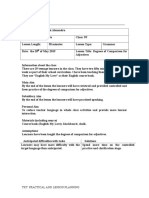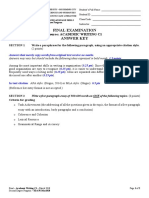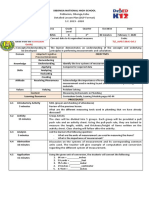0 ratings0% found this document useful (0 votes)
881 viewsFupppp
Fupppp
Uploaded by
Jacinth May BalhinonThe document summarizes the Kalibugan people, also known as Subanun or Subanon, who live in western Mindanao in the Philippines. They are a mixed ethnic group descended from the Subanun and also intermarried with the Tausug and Samal peoples. Most have converted to Islam and their culture shares elements of the Subanun, Tausug, and Samal cultures. They number around 15,000 and live in coastal villages practicing subsistence farming. Villages are led by a chief called a Timuay who settles disputes. They believe souls roam after death unless rituals are performed.
Copyright:
© All Rights Reserved
Available Formats
Download as PPTX, PDF, TXT or read online from Scribd
Fupppp
Fupppp
Uploaded by
Jacinth May Balhinon0 ratings0% found this document useful (0 votes)
881 views14 pagesThe document summarizes the Kalibugan people, also known as Subanun or Subanon, who live in western Mindanao in the Philippines. They are a mixed ethnic group descended from the Subanun and also intermarried with the Tausug and Samal peoples. Most have converted to Islam and their culture shares elements of the Subanun, Tausug, and Samal cultures. They number around 15,000 and live in coastal villages practicing subsistence farming. Villages are led by a chief called a Timuay who settles disputes. They believe souls roam after death unless rituals are performed.
Original Title
fupppp.pptx
Copyright
© © All Rights Reserved
Available Formats
PPTX, PDF, TXT or read online from Scribd
Share this document
Did you find this document useful?
Is this content inappropriate?
The document summarizes the Kalibugan people, also known as Subanun or Subanon, who live in western Mindanao in the Philippines. They are a mixed ethnic group descended from the Subanun and also intermarried with the Tausug and Samal peoples. Most have converted to Islam and their culture shares elements of the Subanun, Tausug, and Samal cultures. They number around 15,000 and live in coastal villages practicing subsistence farming. Villages are led by a chief called a Timuay who settles disputes. They believe souls roam after death unless rituals are performed.
Copyright:
© All Rights Reserved
Available Formats
Download as PPTX, PDF, TXT or read online from Scribd
Download as pptx, pdf, or txt
0 ratings0% found this document useful (0 votes)
881 views14 pagesFupppp
Fupppp
Uploaded by
Jacinth May BalhinonThe document summarizes the Kalibugan people, also known as Subanun or Subanon, who live in western Mindanao in the Philippines. They are a mixed ethnic group descended from the Subanun and also intermarried with the Tausug and Samal peoples. Most have converted to Islam and their culture shares elements of the Subanun, Tausug, and Samal cultures. They number around 15,000 and live in coastal villages practicing subsistence farming. Villages are led by a chief called a Timuay who settles disputes. They believe souls roam after death unless rituals are performed.
Copyright:
© All Rights Reserved
Available Formats
Download as PPTX, PDF, TXT or read online from Scribd
Download as pptx, pdf, or txt
You are on page 1of 14
KALIBUGAN
Kalibuga" (Kolibugan) means
"mixed breed" and refers to the
Subanun of the Philippines who have
intermarried with the Tausug and
Samal. Kalibugan, who number
about 15,000, live in villages on the
coast in western Mindanao. Most
have converted to Islam. Their
culture shares elements with those of
Subanun, Tausug, and Samal.
The Kolibugan Subanen inhabit the Zamboanga
Peninsula, southern Zamboanga del Norte, and some
parts of Zamboanga del Sur. Their language is similar to
that of the Western Subanen but with some grammatical
differences.
Subanen (also, Subanon and Subanun).
The family is patriarchal while the village
is led by a chief called Timuay. He acts as
the village judge and is concerned with all
communal matters.
Death
The Subanuns or Kalibugans believe that all humans have
souls. The dead are usually buried within the same day, before
sundown. They believe that souls roam the earth unless
certain rituals are made to make it go to heaven or to appease
some spirit in the other world. The ritual is usually a feast
(polohog for the less well-off, and buklog for the more affluent.
The burial party however must bathe before the feast begins.
Marriage is similar to that of other tribes: dowry,
use of a go-between, feasting called Buklog and
the rice rituals. The officiating person is the
Misala-getaw who is a respected male leader in
the area. The most important part is the
witnessing of the rice ritual by the groom and
bride. Divorce is permitted and decided by the
village chiefs. In such cases, the dowry must be
returned if the bride is at fault.
In late pregnancy, a special hut called "ghosina" is
erected for the expectant mother. After delivery, the
mother lies close to a hot fire for several days in the
belief that this will dry up the womb.
The Subanuns and Kolibugans practice swidden
agriculture (slash and burn) on the mountain slopes,
cultivating upland rice, corn, root crops, and the like.
They have a subsistence economy and are in need of
technical skills, capital and market access.
The Subanun villages are ruled by village chiefs who
dispense justice, divorce, and settle issues and
disputes.
GHOSINA
Family properties which are covered by inheritance
consist mainly of acquired Chinese jars, gongs, jewelry,
and, in later times, currency. The ownership of cultivated
land, the swidden field, is deemed temporary, because
the Subanen family moves from place to place, and
necessitated by the practice of shifting agriculture.
Performing Arts
Subanen women staging a cultural performance at the Subanen
Palad Festival in 2014.
Subanen musical instruments include the gagong, a single brass
gong; the kolintang, a set of eight small brass gongs of graduated
sizes; and the durugan, a hollowed log which is beaten like a drum;
and the drums.
Vocal music includes the chants for the epic, and several types of
songs, which include the dionli (a love song), buwa (lullaby), and
giloy (a funeral song for a dead chieftain).
You might also like
- Math in Focus: Singapore Math: Enrichment, Book A Grade 2 Math in Focus: Singapore Math: Enrichment, Book A Grade 2Document4 pagesMath in Focus: Singapore Math: Enrichment, Book A Grade 2 Math in Focus: Singapore Math: Enrichment, Book A Grade 2Md. Sazzad Hossain50% (2)
- NEGRITOSDocument9 pagesNEGRITOSJessaMae AlbaracinNo ratings yet
- Mangyan TribeDocument31 pagesMangyan TribeNicole Fadrique100% (1)
- Cultures of Mindanao (18 Tribes)Document29 pagesCultures of Mindanao (18 Tribes)Marie Yah100% (3)
- Approaches To Applied Semiotics (AAS) Persuasive Signs The SemDocument208 pagesApproaches To Applied Semiotics (AAS) Persuasive Signs The SemFlorina GomoescuNo ratings yet
- Focus 1 - Unit 1 Unit TestDocument6 pagesFocus 1 - Unit 1 Unit TestMehmetcan TümerNo ratings yet
- Manobo Tribe ReportDocument13 pagesManobo Tribe ReportNova Starr100% (2)
- Who Are The Batak People?: PhilippinesDocument17 pagesWho Are The Batak People?: PhilippinesJason DimituiNo ratings yet
- TagbanuaDocument25 pagesTagbanuaregie odiamarNo ratings yet
- Group2 KaaganDocument11 pagesGroup2 KaaganHannah Katreena Joyce Juezan100% (1)
- Presentation 5Document84 pagesPresentation 5Chris James Monterola50% (2)
- Kalibugan TribeDocument5 pagesKalibugan Tribeomandacgibson1No ratings yet
- Subanen HistoryDocument19 pagesSubanen HistoryKim Tagupa Taburada100% (2)
- Tausug CultureDocument40 pagesTausug CultureKyutNo ratings yet
- FuppppDocument9 pagesFuppppJacinth May Balhinon50% (2)
- ALBA SANGIL TRIBE FinalDocument15 pagesALBA SANGIL TRIBE FinalRITCHELL ANN DEMAVIVAS GABOT100% (1)
- HigaononDocument1 pageHigaononLansing100% (2)
- B'laan, Bukidnon, Higaonon and T'boli Tribe of MindanaoDocument33 pagesB'laan, Bukidnon, Higaonon and T'boli Tribe of MindanaoFloreann BascoNo ratings yet
- 7 Tribes of Buk. BSHM 1b 2semDocument11 pages7 Tribes of Buk. BSHM 1b 2semJea Sumaylo HamoNo ratings yet
- BagoboDocument2 pagesBagoboJohnny Abad100% (1)
- Tau-Buid Mangyans: Rel-Ed 5Document9 pagesTau-Buid Mangyans: Rel-Ed 5Arch MendozaNo ratings yet
- SubanenDocument20 pagesSubanenDominic75% (8)
- The Mandaya People of MindanaoDocument7 pagesThe Mandaya People of MindanaoKhristian Joshua G. JuradoNo ratings yet
- Ritwal NG Mga T'boliDocument2 pagesRitwal NG Mga T'boliAnonymous PlatypusNo ratings yet
- Marriage and Weddings of Aeta in CabatuanDocument4 pagesMarriage and Weddings of Aeta in CabatuanRachel AbobotoNo ratings yet
- The Organization Has in Its Fold More Than 500 Families in Four Barangays - Agutayan, Rabor, Pasig, and MelvilleDocument4 pagesThe Organization Has in Its Fold More Than 500 Families in Four Barangays - Agutayan, Rabor, Pasig, and Melvilleboerd77No ratings yet
- Mamanwa Tribe-Wps OfficeDocument23 pagesMamanwa Tribe-Wps OfficeDEVINE GRACE VILLARIN100% (1)
- Manobo GroupDocument11 pagesManobo GroupJibesa0% (1)
- Mandaya: Presented By: Cutad, Ray Dag-Uman, Ely Mae Cortes, MaikoDocument24 pagesMandaya: Presented By: Cutad, Ray Dag-Uman, Ely Mae Cortes, MaikoAPPLE MAE AGOSTONo ratings yet
- History of TirurayDocument3 pagesHistory of TirurayStandin Kemier100% (1)
- ABAKNONDocument10 pagesABAKNONapriljoymelchor2No ratings yet
- KankanayDocument2 pagesKankanaysharieborja100% (1)
- MimaropaDocument104 pagesMimaropagiq07100% (1)
- The Tagbanua TribeDocument5 pagesThe Tagbanua TribeMorales Sha Julano Eleazar100% (2)
- Palaw'An Tribe: DescriptionDocument3 pagesPalaw'An Tribe: DescriptionKeziah MillonesNo ratings yet
- AGUSAN DEL NORTE SummaryDocument7 pagesAGUSAN DEL NORTE SummaryTATEL JERRY B.No ratings yet
- Mamanwa-WPS OfficeDocument5 pagesMamanwa-WPS OfficeScaireNo ratings yet
- G4 MamanwaDocument11 pagesG4 MamanwaWyndell AlajenoNo ratings yet
- The Igorots: Distinctive Features of IgorotsDocument2 pagesThe Igorots: Distinctive Features of IgorotsAnnabelle DukaNo ratings yet
- The Talaandig: Belief SystemDocument9 pagesThe Talaandig: Belief SystemPayMaya Communities100% (1)
- Bangsamoro TribesDocument10 pagesBangsamoro TribesAvliah Tabao Datimbang100% (1)
- Region 9Document26 pagesRegion 9Jeane DagatanNo ratings yet
- IfugaoDocument3 pagesIfugaoJhun Gajardo JhunNo ratings yet
- Talaandig: A Cultural Tribe Originated in BukidnonDocument8 pagesTalaandig: A Cultural Tribe Originated in BukidnonSoffia Liezell PajeNo ratings yet
- TADYAWANDocument8 pagesTADYAWANJet Oquendo100% (2)
- The Ten Bornean Datus and The Purchase of PanayDocument2 pagesThe Ten Bornean Datus and The Purchase of PanayUmayao Christine78% (9)
- SOCCSKSARGENDocument14 pagesSOCCSKSARGENVencint Karl Tacardon0% (2)
- Batak Tribe in PalawanDocument10 pagesBatak Tribe in PalawanLorelei HericoNo ratings yet
- HIGAONONDocument2 pagesHIGAONONNicole Watiwat100% (2)
- Ibanag TribeDocument10 pagesIbanag TribedaveacselgalvezNo ratings yet
- The Bagobo Tribe in The PhilippinesDocument2 pagesThe Bagobo Tribe in The PhilippinesJustine Airra OndoyNo ratings yet
- Region X Northern Mindanao HandoutDocument4 pagesRegion X Northern Mindanao HandoutSarah Mae BarrientosNo ratings yet
- Traditional Costumes and AttireDocument11 pagesTraditional Costumes and AttireEllecarg Cenaon Cruz100% (3)
- TAGBANUADocument3 pagesTAGBANUAlelland EnteraNo ratings yet
- IbanagDocument3 pagesIbanagRia BrogadaNo ratings yet
- Maranao CultureDocument15 pagesMaranao CultureAdrienne Margaux DejorasNo ratings yet
- The BadjaosDocument16 pagesThe BadjaosClaire Ann LorenzoNo ratings yet
- Types of Social OrganizationDocument32 pagesTypes of Social OrganizationSamson EbengaNo ratings yet
- REGION12Document33 pagesREGION12kinahNo ratings yet
- Waray PeopleDocument15 pagesWaray PeopleJackie Carlo C. QuilacioNo ratings yet
- AbraDocument18 pagesAbraObed Andalis0% (1)
- Davao Region 11Document14 pagesDavao Region 11Garcia, Jannah Marie P.No ratings yet
- Kalibugan: Rebuplic of The Philippines Sultan Kudarat State University Tacurong, Sultan KudaratDocument2 pagesKalibugan: Rebuplic of The Philippines Sultan Kudarat State University Tacurong, Sultan KudaratJacinth May BalhinonNo ratings yet
- Krishnauniversity: Machilipatnam, A.PDocument6 pagesKrishnauniversity: Machilipatnam, A.PIndiaresultNo ratings yet
- A Comparative Analysis of The Taximan AnDocument8 pagesA Comparative Analysis of The Taximan AnMemal pinoyNo ratings yet
- Indo-Persian Literature and Amir Khusro PDFDocument17 pagesIndo-Persian Literature and Amir Khusro PDFHiya SebNo ratings yet
- Mao - Social For Learning - A Mixed Methods Study On High School Students Technology Affordances and PerspectiveDocument11 pagesMao - Social For Learning - A Mixed Methods Study On High School Students Technology Affordances and PerspectiveRamanditya WimbardanaNo ratings yet
- CV Example TemplateDocument4 pagesCV Example TemplateMaryroseNo ratings yet
- A Study On Employees Participation in Voltech Group of Companies ChennaiDocument1 pageA Study On Employees Participation in Voltech Group of Companies ChennaiThiru VenkatNo ratings yet
- f4 LeavingDocument20 pagesf4 LeavingCady SooNo ratings yet
- Scale Ratings For English Speaking Asses PDFDocument3 pagesScale Ratings For English Speaking Asses PDFУкраїнська філологіяNo ratings yet
- Core 02 PersonalTypographyDocument9 pagesCore 02 PersonalTypographyrgrNo ratings yet
- Mapeh Arts Grade 9 Pe Pre Test For 2nd QuarterDocument3 pagesMapeh Arts Grade 9 Pe Pre Test For 2nd QuarterJAYMAR GONZALESNo ratings yet
- Planificacion Semanal Todas Las ClasesDocument19 pagesPlanificacion Semanal Todas Las ClasesJorge Luis AlarconNo ratings yet
- B2.1 - Utopian Community ProjectDocument3 pagesB2.1 - Utopian Community ProjectAngie MNo ratings yet
- Student Perception About Wearing Veil in UiiDocument5 pagesStudent Perception About Wearing Veil in UiiSri SardiyantiNo ratings yet
- School Improvement Plan: Republic of The Philippines Department of Education Region 02 Schools Division of Nueva VizcayaDocument20 pagesSchool Improvement Plan: Republic of The Philippines Department of Education Region 02 Schools Division of Nueva VizcayaClarissa Flores Madlao MendozaNo ratings yet
- Lesson Plan: TKT: Practical and Lesson PlanningDocument2 pagesLesson Plan: TKT: Practical and Lesson PlanningioanNo ratings yet
- Annayaa's Anthropology Additional English - Asynchronous AssignmentDocument2 pagesAnnayaa's Anthropology Additional English - Asynchronous AssignmentAryan ChaturvediNo ratings yet
- 2016 Undergraduate Academic ScheduleDocument4 pages2016 Undergraduate Academic Scheduleanisarahma718No ratings yet
- Sustainable TourismDocument11 pagesSustainable TourismSumit Ghosh100% (1)
- Poverty and FaminesDocument4 pagesPoverty and FamineskarnsatyarthiNo ratings yet
- SD - Final - Academic Writing C1 - Mar2018 - KEYDocument2 pagesSD - Final - Academic Writing C1 - Mar2018 - KEYne xemNo ratings yet
- Pula High School Senior High School Final Exam 21 Century Literature of The Philippines and The WorldDocument2 pagesPula High School Senior High School Final Exam 21 Century Literature of The Philippines and The WorldMelvin Yolle SantillanaNo ratings yet
- QueeringDocument57 pagesQueeringDereck AndrewsNo ratings yet
- Ebook Philosophy of MusicDocument196 pagesEbook Philosophy of Musicanem2008100% (5)
- Who Are The Aryans?Document5 pagesWho Are The Aryans?Pratap Mulnivasi50% (2)
- The Quest of Completeness Mohan RakeshsDocument3 pagesThe Quest of Completeness Mohan RakeshsbhabakoindriNo ratings yet
- Sibonga National High School: Curriculum Guide TLE - IAPB7/8MC-0d-2Document2 pagesSibonga National High School: Curriculum Guide TLE - IAPB7/8MC-0d-2Ian VarelaNo ratings yet
- Globalisation's Cultural ConsequencesDocument14 pagesGlobalisation's Cultural ConsequencesAnonymous dLDx0vNo ratings yet





